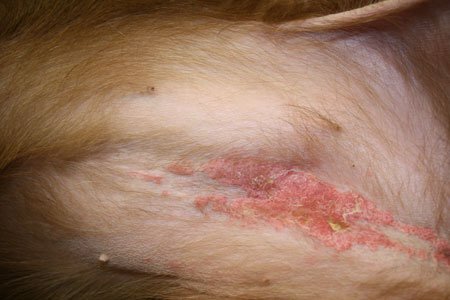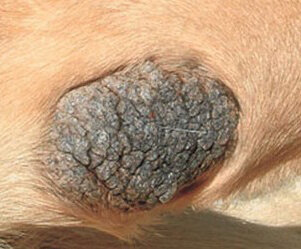Health of the Kerry Blue Terrier
Health Categories
1, Genetics
2. General Health Conditions:
Teeth
Eyes
Genetic Conditions
Health & Genetic Resources
Breeding
Genetics
Canine Inherited Disorders Database (URL)
All breeds of dogs have the potential to develop genetic health problems, no different than humans. Breeders of Kerry Blues should have full background and knowledge of the genetics of any litters they have bred. All Kerry breeders must agree to complete all tests and the results, positive or negative, are published in the CHIC database. You may check CHIC’s website to see if a breeder’s dogs indeed have these certifications. A reputable breeder will always be honest and open about any health problems in their litter and will known the incidence with which they could occur.
Cerebellar Abiotrophy (Cerebellar Degeneration) - A disease that affects puppies and it can progress to paralysis. This is a progressive degenerative condition affecting the nervous system, and will cause limb stiffness and head tremors initially. With progression, it causes those pups affected to lose co-ordination and they will stumble and trip before they are finally unable to stand. This disease affects the young and signs are evident in puppies aged between 2-6 months and compound with the inability to stand occurring by approximately 1 year of age.
Degenerative Myelopathy - The condition is usually found in middle-aged to older dogs, with a range from 4-14 years. Degenerative myelopathy (DM), is a disease affecting the spinal cord of the dog, and results in a slow progressive hind limb weakness and eventually paralysis. The symptoms result from degeneration of the white matter of the spinal cord. DM is very similar to some variations of human amyotrophic lateral sclerosis (ALS) more commonly known as Lou Gehrig’s Disease.
Skin Problem - Kerries are often affected by skin problems including cysts, dermal cysts, corns in their foot pads, as well as Naso-digital Keratoses (when the nose and pads become dry and cracked). Visit Lumps, Bumps and Lesions, for photos and descriptions.
Keratoconjunctivitis Sicca (Dry Eye) is caused by insufficient tear production and can require life-long treatment and management. Kerries are prone to eye problems no matter where you live. These may also include entropion, which is when the eyelids turn inwards, causing the eyelashes to sit against the eyes itself. This could lead to chronic eye irritation and corneal ulceration, which is very painful.
vonWillebrand’s Disease - is the most common inherited bleeding disorder of both humans and dogs. It is caused by a deficiency of a specific protein in the blood needed to help platelets (the blood cells used in clotting) stick together and form clots to seal broken blood vessels.
Hip Dysplasia - This condition occurs when the joint comes to be when the hip bone and the end of the thigh bone (femur) do not sit together properly. This can cause the femur to pop in and out of the joint as the dog moves. Over time it can damage the cartilage and boney structures inside and surrounding the joint. Long-term, your Kerry Blue could have early-onset osteoarthritis.
The United States Kerry Blue Terrier Club, which is the American Kennel Club parent organization for the breed in the United States, participates in the Canine Health Information Center Program. For a Kerry to achieve CHIC certification, he must have a hip evaluation from the Orthopedic Foundation for Animals (OFA) or the University of Pennsylvania (PennHIP) and eye clearances from the Canine Eye Registry Foundation. Tests that are recommended but not required are DNA tests for von Willebrand’s disease, factor XI deficiency, and degenerative myelopathy.
All breeders must agree to have for you all test results -- positive or negative -- as they are published in the CHIC database. You may also check the CHIC’s website to find if a breeder’s dogs have these certifications.
It is not wise to purchase a puppy from a breeder who cannot provide written documentation that the parents of the litter are cleared of the health problems that affect the breed. A vet cannot determine if you puppy is clear.
Please keep in mind, just like you try to be healthy, a Kerry Blue needs to be feed correctly and exercised daily. Now that you have taken a new puppy into your home, you have the power to protect him from obesity, which is a major health factor for all pets. A Kerry Blue that maintains an appropriate weight can easily extend his life expectations. Keep your Kerry healthy!
Lumps Bumps and Lesions
Photos are from all breeds of dogs.
Abscesses
Description: Infected wound or bite anywhere on body
Symptoms: Firm or fluid filled noduleVary in shape and size
Treatment: May have signs of infection (fever, lethargy, decrease appetite)May need surgical intervention to drain and clean woundMay need antibiotics
Acral Lick Dermatitis
Description: Self licking resulting in skin traumaCaused by anxiety, boredom, stress
Symptoms: Self licking resulting in skin traumaCaused by anxiety, boredom, stress. Red, hairless area; can become infected and drain.
Treatment: Treat cause through behavior modification or medication
Allergic & Irritant Contact Dermatitis
Description: Allergic reaction or red inflammation caused by irritating substances.
Symptoms:Possibly small lumps or blisters; itchy.
Treatment: May need steroids or antihistamines
Basal Cell Tumor
Description: Cancerous, slow growing, and rarely metastasizes.Small fluid filled nodules,
Symptoms: May ulcerate.
Treatment: Surgical removal is necessary
Calcinosis Cutis
Description: Mineralization of the skin due to corticosteroids (prednisone)
Symptoms: Hard nodules that ulcerate and drain, develop crusts. May be a sign of Cushing’s Disease.
Treatment: May need surgical removal May need steroid reduction.
Callus
Description: Chronic pressure point.
Symptoms: Thick, hairless areas over pressure points.
Treatment: Provide softer bedding.
Follicular or
Sebaceous Cyst
Description: Most common cyst. Benign.
Symptoms: Round nodules on the skin; may contain thick secretion that is yellow to grey.
Treatment: Surgical removal is optional
Hemangio-sarcoma
Description: Malignant and invasive tumor.
Symptoms: Blue to reddish black.
Treatment: Surgical removal, with removal of borders may require amputation of limb.
Histiocytoma
Description: Benign tumor typical in younger dogs.
Symptoms: Solitary raised, red lump; strawberry like, common on legs, head and ears.
Treatments: Generally resolve on their own; elective surgical removal
Lipoma
Description: Benign fatty tumor.
Symptoms: Single, soft lump; can become large and hinder movement.
Treatment: Surgical removal if they become large or interfere with movement.
Mammary Gland Tumor
Description: Most common in unsprayed females. May be malignant.
Symptoms: Nodules under the skin; irregular shape and size, may ulcerate and drain.
Treatment: Biopsy and surgical removal.
Melanoma
Description:Malignant
Symptoms: Single, dark growth.
Treatment: Surgical removal with large area around tumor.
Spiculosis
Canine spiculosis is a rare congenital skin disease of male Kerry Blue Terriers.
Description:Benign; seen mostly in intact male KBT.
Symptoms: Multiple hard brittle, hair like; mostly over hock region.
Treatment: No treatment unless very itchy.
Warts (Papilloma)
Description:Benign growth caused by virus.
Symptoms: Light color with cauliflower appearance; lips, tongue, eyelid or mouth usually.
Treatment: May biopsy, tend to resolve on own.













